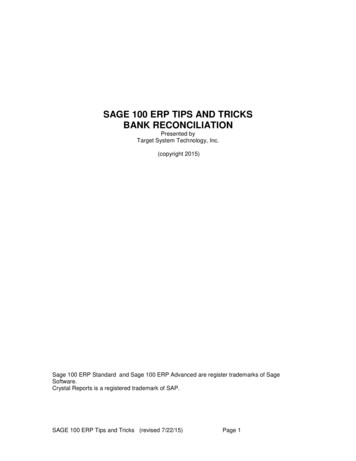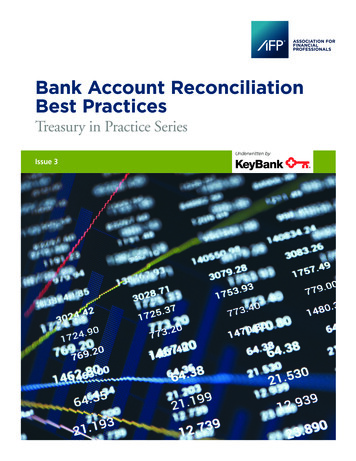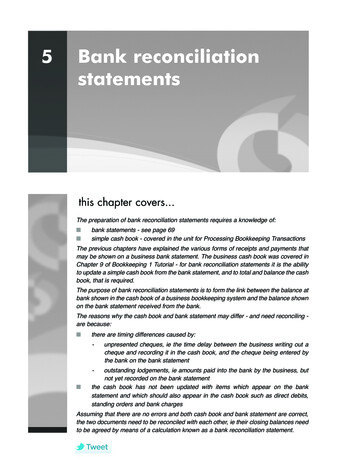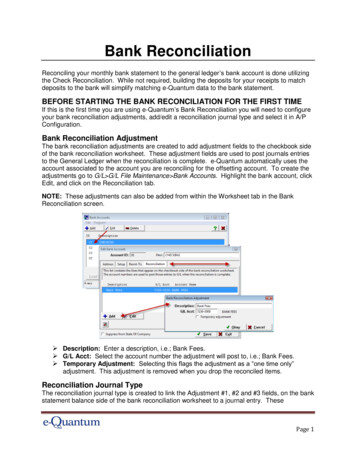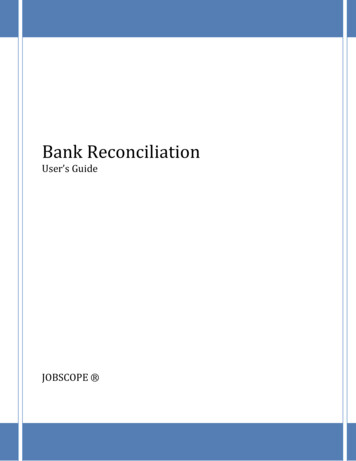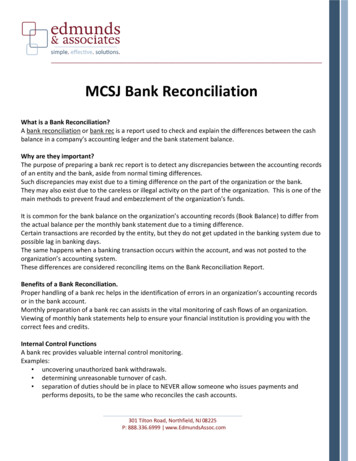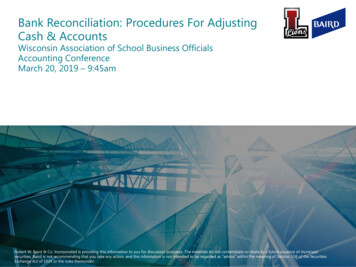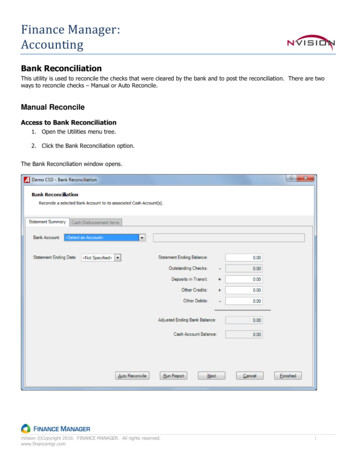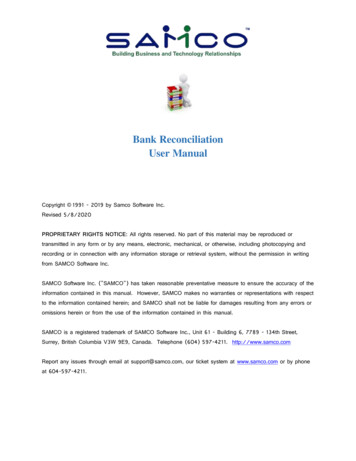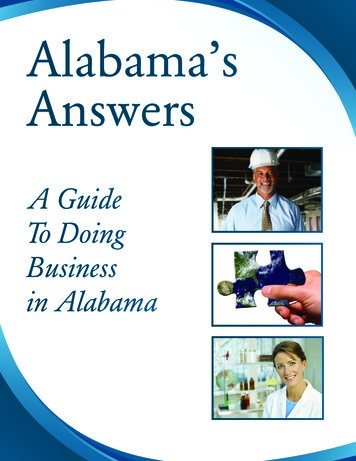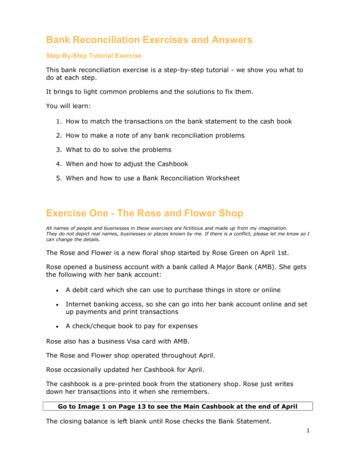
Transcription
Bank Reconciliation Exercises and AnswersStep-By-Step Tutorial ExerciseThis bank reconciliation exercise is a step-by-step tutorial - we show you what todo at each step.It brings to light common problems and the solutions to fix them.You will learn:1. How to match the transactions on the bank statement to the cash book2. How to make a note of any bank reconciliation problems3. What to do to solve the problems4. When and how to adjust the Cashbook5. When and how to use a Bank Reconciliation WorksheetExercise One - The Rose and Flower ShopAll names of people and businesses in these exercises are fictitious and made up from my imagination.They do not depict real names, businesses or places known by me. If there is a conflict, please let me know so Ican change the details.The Rose and Flower is a new floral shop started by Rose Green on April 1st.Rose opened a business account with a bank called A Major Bank (AMB). She getsthe following with her bank account: A debit card which she can use to purchase things in store or online Internet banking access, so she can go into her bank account online and setup payments and print transactions A check/cheque book to pay for expensesRose also has a business Visa card with AMB.The Rose and Flower shop operated throughout April.Rose occasionally updated her Cashbook for April.The cashbook is a pre-printed book from the stationery shop. Rose just writesdown her transactions into it when she remembers.Go to Image 1 on Page 13 to see the Main Cashbook at the end of AprilThe closing balance is left blank until Rose checks the Bank Statement.1
You will notice that there are no currency symbols in the Cashbook, except for theopening balance. This is because Rose does not operate foreign currency accounts andshe and the bank know that her account is in the currency of their country, therefore,there is no need to go through the tediousness of entering a currency symbol with everytransaction.Checking the Bank Statement Against the CashbookAt the beginning of May, Rose received a Bank Statement from AMB.Go to Image 2 on Page 14 to see the Bank StatementNow Rose is ready to reconcile the bank statement and cashbook.She lays them side by side on her table.She has a ruler, a pen and a highlighter.2
Ticking the Correct TransactionsYou may notice in our image examples that the tick marks look like little, pointyhats. This type of tick mark can be quicker to write, and neater than a standard tickmark on which the upward stroke can end up being very long depending on a person’shandwriting and look messy!You can use any tick symbol that you are comfortable with – there is no hard rule aboutthis. You can use a pen or a pencil. Pencil marks can be erased afterwards if you don'twant them to remain on the documents.Rose puts the ruler under the first transaction on the Bank Statement - it showsan internal transfer of 500 in the Money In column She looks across to her Cashbook and sees the 500 in the Money InColumn Both transactions are correct, so Rose puts a small tick mark next to each Then Rose moves the ruler down to the next transaction on the bankstatement It is for a loan amount of 1,500 which Rose had applied for from the bank She looks across to her Cashbook and sees that she had entered the 1,500into the Money In column Both transactions are correct, so Rose puts a small tick mark next to each She continues to work down the Bank Statement and looking across to theCashbook and ticking off the correct transactions.Highlighting Missing or Different Transactions On 8 April Rose sees that she has entered 350 twice into the Cashbook inerror One entry says Cash Machine and the other says Petty cash box She highlights the transaction on the bank statement with her yellowhighlighter because she wants to check the invoice/receipt from OfficeSupplies, after which she will know what she must do in the Cashbook She highlights the error in the cashbook Rose starts a list on a separate piece of paper noting each error ordifference that she needs to investigate and correctGo to Image 4 and 5 on Page 15-16 to seethe ticked Bank Statement and Cashbook3
List of All Bank Reconciliation Errors or DifferencesRose continues to move down through the Bank Statement with her ruler andticking the matching transactions, or highlighting transactions on the BankStatement that do not match.With each highlighted entry, Rose continues to write the differences on her querieslist.Professional Bookkeepers would probably skip this step of writing a list ofquestions. Instead, as soon as they come to the first problem, they will look it up, figureout how to fix it and sort it out right away.Why?To save time by not double-handling the same problem, that is, they are not highlightingand writing down the problem (first handling) and then later going to investigate whythe problem occurred and then fixing it (second or even third handling).Here is the final list:4
Query OneWhy is 350 entered twice?Answer:The receipt from Office Supplies shows her that the Cash Machine (also known asa Cash Till) was 300 and the Petty Cash Box was 50.Solution:One of the 350 entries must be reversed ('removed' from the Cashbook).Query TwoWhy are the kitchen supplies 55 not on the bank statement?Answer:The Cashbook Reference column indicates ‘Cash’ was used. Rose looks in the PettyCash box and finds the receipts in there. The items were brought with money fromthe Petty cash box and so they should not be in the Cashbook for the bankaccount.Solution:This entry must be ‘removed’ from the bank Cashbook page, and a new recordmust be started for the transactions in and out of the Petty Cash box. This can bedone with a Petty Cash Log.Query ThreeWhy is BT payment of 102.50 split in the Cashbook?Answer:It is split because two different types of expenses were purchased and so theyneeded to go to different accounts (vehicle costs and telephone)Solution:The split in the Cashbook is fine. Leave as is.Query FourWhy is there an OD fee of 10?Answer:The bank account went into overdraft. Rose does not have an arranged overdraftfacility with the bank, so they charged her 10.Solution:Enter it into the Cashbook.5
Query FiveWhy is 90 to glass cleaners not on the Bank Statement?Answer:Cash was used to pay for this. Rose checked the Petty Cash box, but it was nottaken from there. She remembers using her own cash to pay.Solution:Keep receipt and give to Accountant to enter into the bookkeeping system using ajournal.Query SixWhy has the bank done a deposit correction of 50.Answer:Rose checks the original deposit paperwork and calculations and sees that herassistant Alice did not add up the receipts correctly. The bank is correct to makethis adjustment.Solution:Include the adjustment in the Cashbook.Query SevenWhy is Ch 0004 not on Bank Statement?Answer:Rose checks the check/cheque book and she looks at her bills. She knows sheposted the check to the sign writers and so they probably did not get it depositedbefore the month end.Solution:This will be adjusted using the Bank Reconciliation Worksheet.Query EightWhy are the travel costs of 210 not on the Bank Statement?Answer:The Cashbook reference is ‘Bank Card’. Rose remembers that she used thebusiness Visa Card, not the bank card. However, she is still waiting for the Visacard statement which the bank will only send out in the middle of May.Solution:‘Remove’ this transaction from the bank account Cashbook and start a separateCashbook page for the Visa card transactions.6
Query NineWhy are none of the bank fees not in the Cashbook?Answer:Rose wasn’t aware of them until she got the bank statement, although if she hadchecked her bank account online more closely she would have seen them.Solution:Enter them into the Cashbook.Query TenWhat is the 110 AMB Loans?Answer:Rose checks her loan paperwork and sees that this is the regular monthlyrepayment. It is for 90 principal and 20 interest.Solution:Enter to the Cashbook.Query ElevenRight at the end, after checking the Petty Cash Log, Rose saw that 80 wasdeposited into the Cash Box.Answer:She checks this for accuracy against the Cash Book and sees that the full 200 on8 April was entered to the Cash Box account although the description explains it isfor the cash box and the cash machine.Solution:Adjust the amount in the Cashbook to show 80 to Cashbox and 120 to CashMachine.Here is Rose’s list with her answers:7
Cashbook AdjustmentsRose works through her list of solutions to adjust the Cashbook at the bottom.If she did not have enough room at the bottom, she would simply turn the pageand do it there because she is using a pre-printed Cashbook which has lots oflined pages.If she was using lined pages printed off her computer she would just print morepages as she needs them.First Group of Adjustments:Transactions on Bank Statement Missing from CashbookThe first thing Rose does is to enter into the Cashbook the transactions from theBank Statement that were missing from the Cashbook, which were: 1. Difference No. 4 – the overdraft fee of 102. Difference No. 6 – the Deposit correction of 503. Difference No. 9 – the three different types of bank charges4. Difference No. 10 – the loan repaymentThese are all straight forward entries.She dates them at the date showing on the Bank Statement even though enteringthem after the transactions dated April 30th in the Cashbook – a mixed date orderwithin the same month is not a huge problem.Second Group of Adjustments:Transactions in Cashbook That Were Entered IncorrectlyThe second thing Rose does is to enter adjusting entries for the transactions thatwere wrong in the Cashbook, which were:1. Difference No. 1 – The double entered 350.00.How: The adjustment is entered to the Money In column in the Cashbook toput the Cashbook back up to a correct balance. Look at the balance beforethe entry was made and look at it after this entry was made.2. Difference No. 2 – The kitchen supplies entry of 55How: This adjustment is also entered to the Money In column, same reasonas difference no. 18
3. Difference No. 3 – The Split purchase of 102.50How: Nothing is done here because the split amount still adds up to 102.50 and so the Cashbook bank balance is correct.4. Difference No. 5 – The 90 for the window cleaners.How: This adjustment is also entered to the Money In column, same reasonas difference no. 1 and 2 above.5. Difference No. 8 – The hotel payment of 210.How: This adjustment isalso entered to the Money In column, same reason as difference no. 1,2 and5 above.Rose dates them all at April 30th but indicates in the Details column the date ofthe original transaction entry in the Cashbook.At this stage Rose could also go back to the Bank Statement and tick off thehighlighted transactions to show that they have now all been dealt with.Go to Image 5 on Page 17 for the Updated CashbookRose has now: updated the Bank Balance column totalled the Money In and Money Out columns updated the bank balance column double-checked her calculations and ticked the totals with a different kind of'checked' mark - a C with a line through it.There is still a difference in the Cashbook of 350 which is due to the unpresentedcheck/cheque from Query No. 7.The next step will be to make a bank reconciliation worksheet to include this 350into the calculations.How to Know When to Use A Reconciliation Worksheet VsAdjusting the CashbookThere are always two main steps to get the bank account and cashbook balancedto each other if they are unbalanced.First Step: Adjust the cashbookSecond Step: Use a bank reconciliation worksheet template9
Sometimes it will only be necessary to process just the first step, or just thesecond step, depending on what transactions are missing or wrong.If you deal with purely modern online banking and do not issue or receivechecks/cheques, you will not have to use a Bank Reconciliation Worksheet.This list will help you decide if you should adjust the Cashbook or use a BankReconciliation Worksheet or to do both. If you know that a transaction in the Cashbook this month will be on next month’sBank Statement, don’t adjust the Cashbook. Use the Bank Reconciliationworksheet. If a transaction is on this month’s Bank Statement but not in the Cashbook, thenyou must adjust the Cashbook by entering the transaction into the Cashbook thismonth. Don’t use the Bank Reconciliation Worksheet. Any deposits that are showing in your Cashbook but not on the Bank Statement,use the Bank Reconciliation Worksheet Any checks/cheques issued by you in your Cashbook but not on the BankStatement, use the Bank Reconciliation Worksheet Any deposits on the *Bank Statement but not in your Cashbook, adjust theCashbook by entering the deposit in to the Money In column. Any withdrawals on the *Bank Statement but not in your Cashbook, adjust theCashbook by entering the withdrawal in the Money Out column.*Even if the bank has made an error on their Statement, because you will let thebank know and they will adjust their system next month so that it shows on theBank Statement next month; then next month you can adjust your Cashbook tomatch.How to Use A Bank Reconciliation WorksheetGo to Image 6 on Page 18 for the Bank Reconciliation Worksheet (Report)The check/cheque number 0004 dated April 27th is not on the Bank Statement, soRose writes it down in the Unpresented Checks/Cheques box of the BankReconciliation Worksheet.Rose then enters the other amounts i.e. the closing cashbook balance, totals fromBox A and Box B and the Expected Bank Statement Balance into the Reconciliationsection of the worksheet.The Expected Bank Statement Balance of 2,441.50 is the actual closing BankStatement balance so it is good and correct.If it did not come to that on the Bank Reconciliation Worksheet, it would meaneither:10
1. Rose had not done her Cashbook adjustments correctly making the ClosingBank Balance wrong or2. Entered or calculated the Unpresented checks/cheques or
ï 7LFNLQJ WKH &RUUHFW 7UDQVDFWLRQV z } µ u Ç v } ] ] v } µ ] u P Æ u o Z Z ] l u l o } } l o ] l o ] o U } ] v Ç
